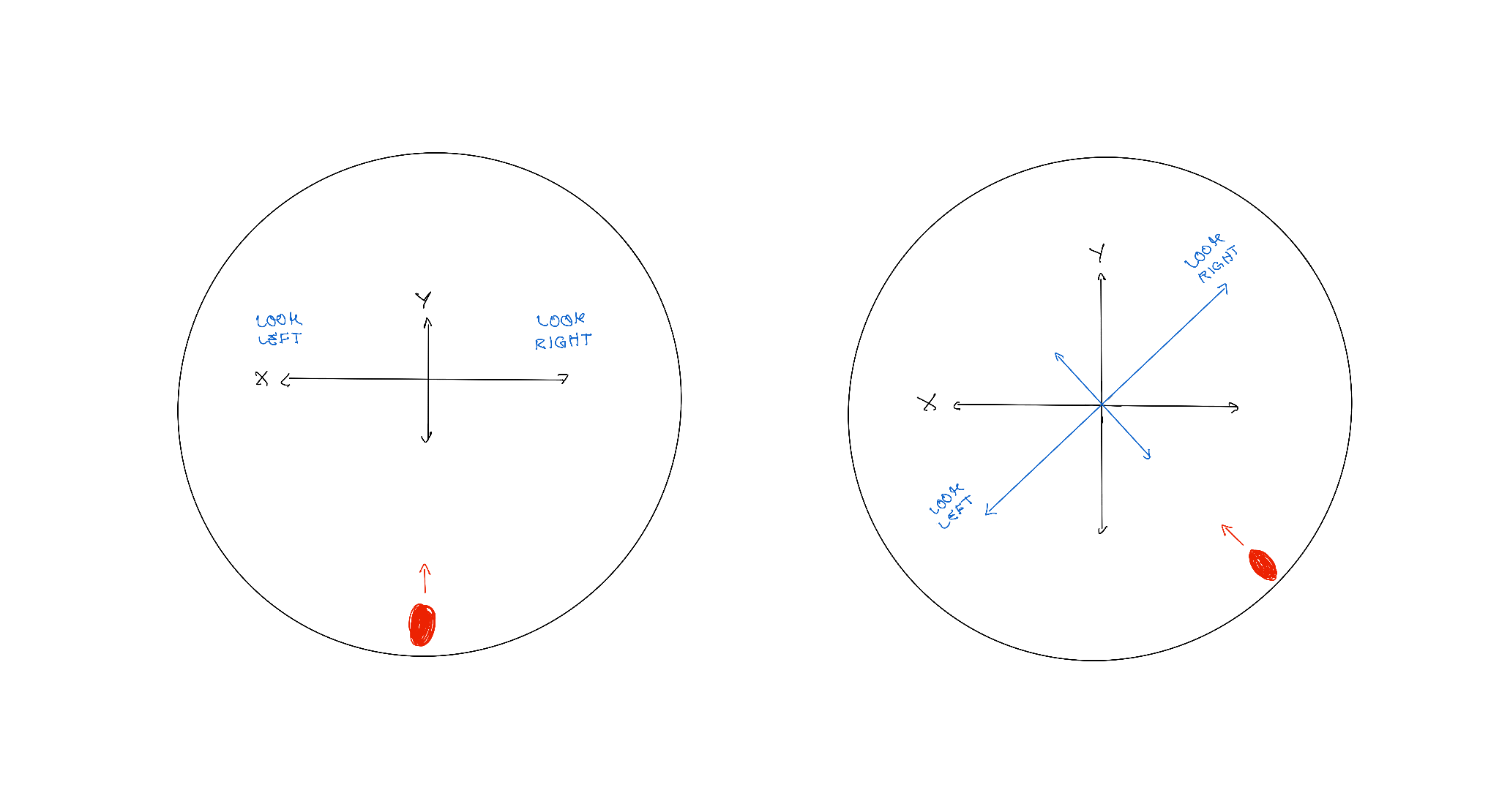- Home /
How to control player camera on angled surface/independent of xyz axis?

I managed to have my player move around the inside surface of a cylinder using gravity but an issue comes up when trying to rotate the camera to look around.
First, there's a script that simulates gravity by pushing the player against the inside walls of the cylinder. This script also keeps the player upright by changing the "up" direction of the player to always be facing the center of the cylinder. I know this keeps my player from looking up so for now I'm just working on getting them to look left and right.
Second, when the player is on the bottom of the cylinder and parallel with the Y-axis I can look left and right without issue because the camera rotates using the x-axis (see circle on the left). However when the player moves around the side of the cylinder the camera is still trying to rotate based on the X-axis even though they are not aligned resulting in the camera not accurately rotating (see the circle on the right), and by the time the player is 90deg around the cylinder cannot rotate at all (thanks to the gravity keeping the player perpendicular to the sides of the cylinder), and at 180deg around the rotation is inverted.
I assume there are two possible solutions that I have not been able to successfully implement: 1. ignore the world xyz axis' and rotate relative to the player's xyz. 2. do some math to figure out the proper angles when you take into account the player's rotation around the cylinder and the angle of the current "left" direction.
The problem with the first solution is I have not been able to successfully rotate the player independent of the world xyz. I tried adding the Space.Self to the Rotate() method but no success. The problem with the second is math scares me and I've managed to avoid Quaternions & Euler angles so far so I'm not even sure how to begin figuring that out.
If anyone has had a similar issue I would greatly appreciate any insight or suggestions on how to figure it out.
Here's my code for the player:
using System.Collections;
using System.Collections.Generic;
using UnityEngine;
using UnityEngine.InputSystem;
public class PlayerController : MonoBehaviour
{
InputManager inputActions;
InputManager.PlayerMovementActions playerMovement;
public GravityAttractor GravityAttractor;
public float moveSpeed = 15;
public float jumpHeight = 10f;
public float sensitivityX = 1f;
public float sensitivityY = 1f;
float mouseX, mouseY;
Vector2 mouseInput;
private bool isJumping = false;
private Vector3 moveDir;
private Vector2 moveInput;
private Rigidbody rbody;
private void Awake()
{
inputActions = new InputManager();
playerMovement = inputActions.PlayerMovement;
playerMovement.Movement.performed += context => moveInput = context.ReadValue<Vector2>();
playerMovement.Jump.performed += ctx => Jump();
//playerMovement.MouseX.performed += context => mouseInput = context.ReadValue<Vector2>();
playerMovement.MouseX.performed += context => mouseInput.x = context.ReadValue<float>();
playerMovement.MouseY.performed += context => mouseInput.y = context.ReadValue<float>();
rbody = GetComponent<Rigidbody>();
isJumping = false;
}
private void Update()
{
moveDir = new Vector3(moveInput.x, 0, moveInput.y).normalized;
if (rbody.velocity.y == 0)
isJumping = false;
}
private void FixedUpdate()
{
rbody.MovePosition(rbody.position + transform.TransformDirection(moveDir) * moveSpeed * Time.deltaTime);
MouseLook(mouseInput);
}
void Jump()
{
//use brackeys method of checking for contact with ground
if(isJumping == false && rbody.velocity.y == 0)
{
isJumping = true;
rbody.velocity = transform.up * jumpHeight;
Debug.Log("player jumped");
}
}
void MouseLook(Vector2 mouseInput)
{
mouseX = mouseInput.x * sensitivityX;
mouseY = mouseInput.y * sensitivityY;
var upTransform = GravityAttractor.transform.position - transform.position;
Vector3 relativeLook = upTransform - transform.forward;
Vector3 qLook = transform.forward - transform.position;
transform.Rotate(transform.up * mouseX * Time.deltaTime, Space.Self);
//transform.Rotate(relativeLook.normalized);
//transform.rotation = Quaternion.LookRotation(qLook);
//transform.Rotate(relativeLook.normalized, mouseX);
}
private void OnEnable()
{
inputActions.Enable();
}
private void OnDisable()
{
inputActions.Enable();
}
}
And my code for the gravity:
using System.Collections;
using System.Collections.Generic;
using UnityEngine;
public class GravityAttractor : MonoBehaviour
{
public float gravityMultiplier = -10f;
private float radius;
public float gravity;
public float distance;
private void Awake()
{
radius = transform.localScale.x/2;
}
public void Attract(Transform body)
{
Vector3 centerOfGravity = new Vector3(transform.position.x, transform.position.y, body.position.z);
distance = Vector3.Distance(centerOfGravity, body.position);
//gravity will match multiplier no matter the radius of cylinder
gravity = gravityMultiplier * (distance/radius);
Vector3 gravityUp = (centerOfGravity - body.position).normalized;
Vector3 bodyUp = body.up;
body.GetComponent<Rigidbody>().AddForce(gravityUp * gravity);
Quaternion targetRotation = Quaternion.FromToRotation(bodyUp, gravityUp) * body.rotation;
body.rotation = Quaternion.Slerp(body.rotation, targetRotation, 50 * Time.deltaTime);
}
}
Is your camera a child of your player? And is this a third person camera or a first person camera?
I think it has to do with how your camera is setup, can you show inspector?
Answer by ahsen35813 · Mar 23, 2021 at 04:22 PM
First of all, I'd like to say that this is a really cool idea!
Did you try using local rotation instead of global rotations ( https://docs.unity3d.com/ScriptReference/Transform-localEulerAngles.html )? If the player orientation is already correct, local rotations might work as long as the camera is parented to the player.
Your answer

